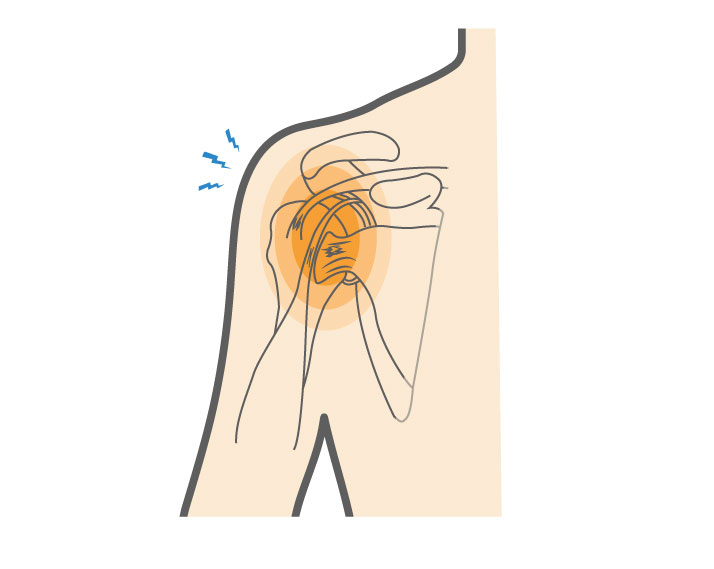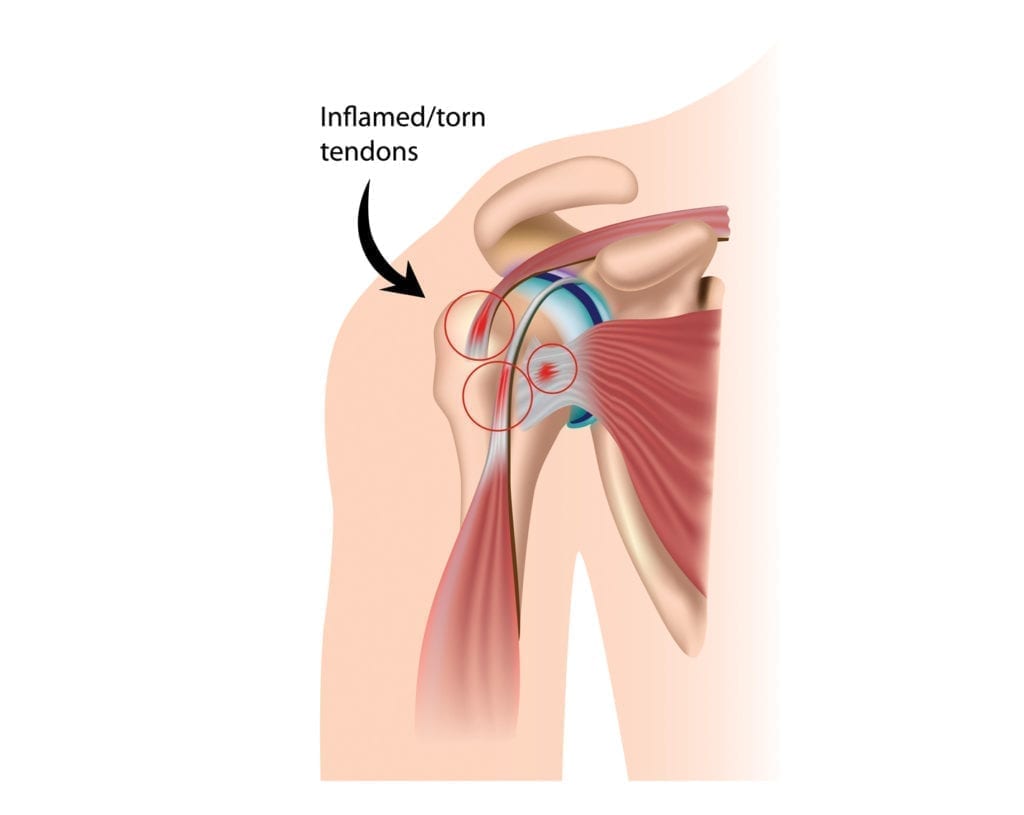Shoulder impingement occurs when the space for the rotator cuff is too small. This can be due to bone spurs from the bone above, called the acromion, or swelling in the rotator cuff muscles when they are overworked or overused due to repetitive overhead motion. This swelling, also referred to as rotator cuff inflammation, is often referred to as rotator cuff tendonitis in the rotator cuff tendon. Tendonitis is a condition characterized by inflammation of a tendon (fibrous tissue that connects muscle to bone) that develops over a period of time. In this case, the muscles and tendons are inflamed but not torn due to tendon overuse.
Impingement Syndrome/Rotator Cuff Tendonitis Treatment
Shoulder impingement occurs when the space for the rotator cuff is too small. This can be due to bone spurs from the bone above, called the acromion, or swelling in the rotator cuff muscles when they are overworked or overused due to repetitive overhead motion. This swelling, also referred to as rotator cuff inflammation, is often referred to as rotator cuff tendonitis in the rotator cuff tendon. Tendonitis is a condition characterized by inflammation of a tendon (fibrous tissue that connects muscle to bone) that develops over a period of time. In this case, the muscles and tendons are inflamed but not torn. This condition often results in shoulder pain when lifting the arm, especially in overhead motions.
Overview
Overview

What causes Impingement Syndrome/Rotator Cuff Tendonitis?
Impingement syndrome occurs from two causes:
- Age-related development of bone spurs on the bone above the rotator cuff, called the acromion.
- Inflammation and swelling in the rotator cuff tendon due to overuse from consistent movements that keep the shoulder over the head, such as pitching a baseball
Weakness of the rotator cuff tendons allows the humerus bone to pull up closer to the acromion, worsening the shoulder impingement.
Rotator cuff impingement and rotator cuff tendonitis are common in these sports:
- Baseball
- Swimming
- Tennis
- Volleyball
- Golf

Symptoms
If you experience symptoms of shoulder impingement, they may be mild at first. You are most likely to experience:
- Shoulder pain when lifting or performing overhead motions, like serving a tennis ball
- Pain on the outside of the shoulder
- Pain that worsens when sleeping on the affected shoulder
- Stiffness in the affected shoulder
If left untreated, symptoms of shoulder impingement and rotator cuff tendonitis can worsen and lead to:
- Loss of mobility in the affected shoulder
- Loss of strength in the affected arm
- Tearing, also referred to as a rupture, of the inflamed tendon
When to see a doctor
If you have pain that does not subside, pain that progressively gets worse, or experience loss of motion, make an appointment to visit an orthopedic specialist. You may have a more serious injury, like a tear of the rotator cuff. During your appointment, your doctor will examine your shoulder by testing its range of motion and the strength of the affected shoulder and the arm. To make a diagnosis, your doctor may prescribe imaging tests to provide proper shoulder impingement treatment, such as:
- X-rays
- MRI
- Ultrasound
Non-operative treatment
The goal of shoulder impingement treatment is to increase the space for the rotator cuff tendons. It is also essential to reduce swelling in the area. One of the most important actions you can take to heal rotator cuff tendonitis is avoiding activities that cause tendon overuse and inflammation. You may also try non-operative treatments to alleviate pain and rotator cuff inflammation associated with rotator cuff tendonitis, such as:
- Resting the affected shoulder and arm
- Applying ice to the affected shoulder
- Anti-inflammatory medication, such as ibuprofen, to reduce swelling
- Physical therapy is used to strengthen the muscles of the shoulder (more specifically, the scapula muscles) and increase the space for the rotator cuff under the acromion.
- Injections for pain relief and to reduce inflammation, such as corticosteroid injections (administered to you by an orthopedic specialist)
You can also try these exercises at home to stretch and strengthen the muscles surrounding the shoulder:
Surgical Treatment
If non-surgical treatments do not relieve your symptoms, then surgery may be considered. The type of surgery used to treat shoulder impingement/rotator cuff tendonitis is called a subacromial decompression.
The goals of surgical treatment of shoulder impingement are to:
- Increase the space for the rotator cuff by removing any bone spurs located on the acromion that may be impinging on the inflamed tendon
- Remove tissue that is recurrently inflamed and/or thickened
Surgery for impingement syndrome is usually performed arthroscopically. Arthroscopy is a minimally invasive surgical technique that uses tiny incisions (roughly one centimeter long) through which special instruments and a camera attached to a thin, flexible tube are inserted into the shoulder. During a subacromial decompression surgery, the surgeon removes the bone spurs and treats any damaged tissue.
Recovery
Depending on the severity of rotator cuff tendonitis, recovery without surgery can take as little as two to four weeks or up to two to four months. If you require surgery, recovery can range from six to 10 weeks.
Following surgery for rotator cuff inflammation, your arm will be placed in a sling. This limits movement and allows the shoulder to heal. Once directed by your doctor, the sling will be removed, and your doctor will start you on an exercise program to strengthen the muscles of the shoulder and help you regain range of motion.
You should not return to overhead sports until you are pain-free and have recovered with full range of motion and strength.
GET BACK TO WHAT YOU LOVE. FASTER
Sources
https://www.healthline.com/health/rotator-cuff-tendinitis
https://orthoinfo.aaos.org/en/diseases–conditions/shoulder-impingementrotator-cuff-tendinitis
https://my.clevelandclinic.org/health/diseases/17449-rotator-cuff-tendonitis
https://www.hopkinsmedicine.org/healthlibrary/conditions/orthopaedic_disorders/rotator_cuff_tendinitis_22,RotatorCuffTendinitis
https://medlineplus.gov/ency/article/000438.htm
https://orthoinfo.aaos.org/en/diseases–conditions/shoulder-injuries-in-the-throwing-athlete/
Frequently Asked Questions
Can shoulder impingement heal on its own?
In mild cases, yes, shoulder impingement can improve with rest, ice, and over-the-counter anti-inflammatory medications. However, if the condition results from ongoing overuse or anatomical issues like bone spurs, professional treatment such as physical therapy or even surgery may be required for full recovery.
How long should I rest before starting physical therapy?
Rest is critical during the acute phase to reduce inflammation. Most people begin physical therapy within a few days to a couple of weeks, depending on the severity of symptoms. Your orthopedic specialist will guide you on the right time for therapy to avoid further strain while promoting healing.
Is surgery always necessary for impingement syndrome or tendonitis?
Not at all. Most people respond well to non-surgical treatments like rest, physical therapy, and corticosteroid injections. Surgery, such as arthroscopic subacromial decompression, is typically only recommended when conservative methods fail to relieve symptoms after several months.
Can I continue playing sports with shoulder tendonitis?
It's best to avoid sports, especially those involving repetitive overhead motions, while you're recovering. Continuing to play with tendonitis may worsen inflammation or even lead to a tear. Always consult your doctor or physical therapist before returning to sports to ensure you're fully healed.

